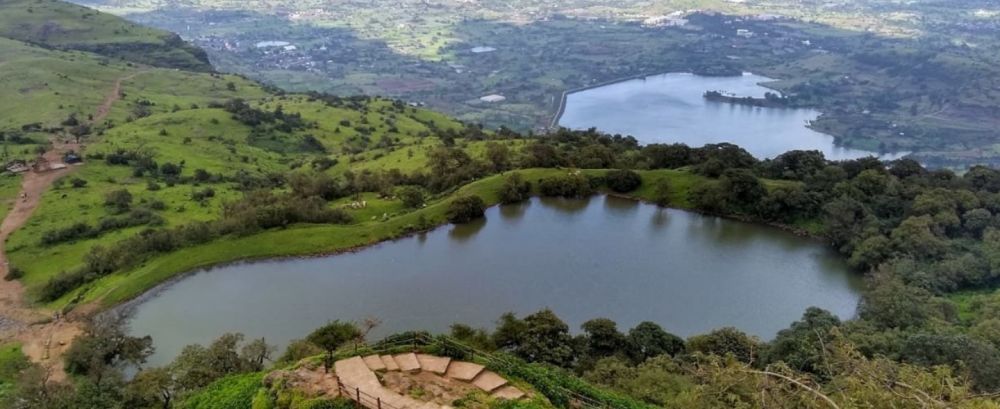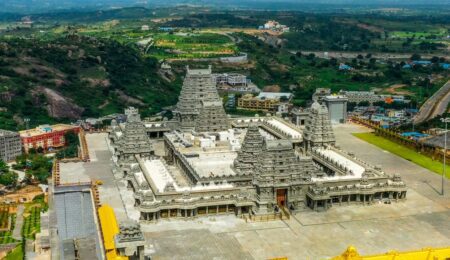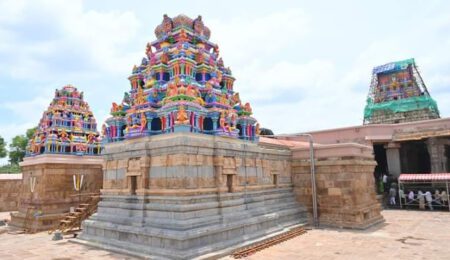Anjaneri Hills: Mythical Birthplace, Biodiversity Haven & Trekker’s Paradise
Perched at around 1,280 m (4,264 ft) in the Trimbakeshwar range of the Western Ghats, approximately 20 km from Nashik, Anjaneri Hills draws millions of visitors—from devout pilgrims tracing Hanuman’s origins to adventure-seeking trekkers and nature lovers eager to explore a riddled terrain of caves, waterfalls, sacred lakes, and rare flora. A declared Conservation Reserve since 2017, the area spans 5.69 sq km and boasts one of the most fragile yet biodiverse ecosystems in Maharashtra
At a Glance:
- Elevation: ~1,280 m (4,264 ft)
- Range: Trimbakeshwar Range, Western Ghats
- Legend: Birthplace of Lord Hanuman
- Unique Flora: Ceropegia anjanerica (endemic, critically endangered)
- Archaeology: 108 Jain caves (11th–12th century)
- Designation: Conservation Reserve since 2017
Essence of Anjaneri Hills: Mythology, History & Cultural Layering
Mythical Origins: Anjani, Shiva & Hanuman
The hill’s spiritual aura stems from the belief that Anjaneri Hills is the birthplace of Lord Hanuman. According to the Bhavartha Ramayana (16th-century saint-poet Eknath), his mother Anjana Devi performed penance on the hill for 7,000 years. Shiva, impressed, incarnated as her son—Hanuman—on these very slopes .
Alternative lore in the Brahma Purana adds layers: Anjana and her friend Adrika (cursed celestial nymphs) performed tapasya, took birth among Vanaras, and regained their heavenly forms through sacred pilgrimage at river tirthas—one of which still bears footprints and waters linked to Hanuman’s legend .
Historical Significance: Jain Meditation, Maratha Retreats & Colonial Visits
11th–12th century later saw the carving of 108 Jain caves into basalt outcrops—meditation chambers for Digambara monks, reflecting Anjaneri’s spiritual cross-pollination between Hindu and Jain traditions .
During the Maratha era, the hill served as a summer retreat for Raghunathrao Peshwa during exile. Under British rule, missionaries from Saharanpur and Malegaon made annual pilgrimages, characterizing Anjaneri as a serene colonial-era pilgrimage destination .
Geographical Layout & Ecosystem Diversity
Topography & Connection to Trimbakeshwar Range
Situated in the Trimbakeshwar Range—part of the Western Ghats—the Anjaneri Hills form a sub-peak within a system that also includes peaks like Brahmagiri (~1,295 m) and Harihar (≈1,120 m) . Its terrain is a rugged mosaic of rocky plateaus, forest cover, meadow stretches, and steep ridgelines.
Flora & Key Biodiversity
- Ceropegia anjanerica, a critically endangered vine, endemic solely to this plateau—its tubers once sustained locals in famine and are still foraged by langurs .
- Surveys identify 350–450 plant species here—nearly 50% with medicinal uses. Local communities rely on non-timber forest products for livelihoods (approx. 57 such products) .
- Faunal residents include Indian striped hyena, leopard, Indian vulture, whiterumped and Egyptian vultures, earning Anjaneri the status of the only vulture conservation reserve in Maharashtra. Over 120 nests for long-billed vultures were recorded in 2015
Ecosystem Services & Conservation Value
Anjaneri functions as a crucial water recharge zone for local aquifers and downstream resources (e.g. Anjaneri dam), contributes fodder, medicinal plant harvest, tourism revenue, and spiritual ecosystem services tied to Hanuman mythology. Any ecological disruption—such as road construction—risks not just biodiversity loss but destabilization of local livelihoods and ancient cultural practices
Trekking Experience: Trail Details & Attractions
Approach & Trailhead
Most trekkers begin from Anjaneri village, reachable via Anjaneri Phata on the Nashik–Trimbak road (~20–26 km from Nashik). From Phata, vehicles can ascend ~1.5 km before the trailhead, reducing trekking effort at the start .
Trek Route & Duration
- Distance: ~3.5–4 km uphill
- Ascent time: 2–3 hours; descent: 1.5–2 hours
- Difficulty: Moderate with rocky and steep stretches, suitable for fit beginners and experienced trekkers .
Highlights Along the Way
- Sita Cave: Two-roomed cavern historically linked to Sita; can accommodate small groups and features Jain-style carvings (.
- Jain Caves & Ancient Cisterns: Numerous rock-cut caves and carved water tanks indicate monastic presence and ingenious water storage .
- Anjaneri Lake (Hanuman Footprint Lake): Natural pond resembling a large footprint; arguably formed by mythic impact and indicated by locals as sacred bathing pond for pilgrims and villagers alike .
- Anjani Mata Temple: Unique shrine dedicated solely to Lord Hanuman’s mother—often visited en route and where devotees pause for prayers .
- Summit Shrine for Hanuman: Infant Hanuman idol (rare), paired with panoramic views of Nashik valley, Brahmagiri, Harihar, and Vaitarna backwaters .
Seasonal Guide & Best Time to Trek
Peak Season: Post-Monsoon to Spring (October–March)
Post-monsoon and winter offer the ideal trekking experience—cool temperatures (~10‑30 °C), lush scenery, full waterfalls, clear spring blooms, and rich visibility .
Monsoon Trekking (June–September)
Monsoons transform Anjaneri into an emerald spectacle—waterfalls cascade, meadows burst with Sonki flowers, Cape York Lily, and other wildflowers. But trails become slippery; waterlogged sections can close, and rescue operations have occurred in flash floods—so only experienced trekkers equipped for heavy rainfall should attempt it .
Avoidance Periods
Steer clear during extreme heat (April–May) and heavy rainfall days. Authorities may restrict access if trails flood or visibility drops. Weekend crowd surges may lead to temporary closures
Conservation Threats & Local Resistance
5Road Construction Proposal & Ecosystem Risk
A proposed 14 km road from Mulegaon to the summit stirred controversy—threatening to clear 12–15 hectares (~15% of 5.7 sq km reserve), derail aquifer recharge, harm endemic plants, and pave the way to increased vehicular traffic & littering .
Community Voices & Government Reactions
Environmentalists, villagers and NGOs raised alarms. Maharashtra’s Environment Minister Aaditya Thackeray tweeted in November 2020 that “the road will not happen as originally proposed” and promised eco-sensitive infrastructure planning . Despite this, local groups remain vigilant in mobilizing support via petitions and social media (#SaveAnjaneri) to protect the rock plateau and vulture habitat .
Flora, Fauna & Biodiversity In-depth
Endemic & Medicinal Plants
Ceropegia anjanerica—rare tuberous vine, critically endangered, known locally as ‘lahaani kharpudi’—once used in famine relief and still foraged by langurs. Not found anywhere else on Earth .
Other plant species: Cape York Lily, Sonki, wild turmeric, seasonal wildflowers. Local survey by Jui Pethe documented over 430 species, half with medicinal uses; 57 forest products support livelihoods of nearby villagers .
Wildlife Highlights
More than 105 bird species, including Yellow-footed Green Pigeon (Maharashtra’s state bird), Short‑toed Snake Eagle, Olive-backed Pipit, Montagu’s Harrier, Peregrine Falcon, and Indian Peafowl, many protected under Wildlife (Protection) Act, 1972 .
Vulture species: Long-billed (Indian), Whiterumped, and Egyptian vultures nest on the cliffs; 120+ nests of long-billed vultures verified in 2015—rare for Maharashtra .
Large mammals: Indian striped hyena, leopard, pangolins, monkeys; amphibians and insects thriving in micro-habitats across the plateau .
Safety, Gear & Trekking Etiquette
What to Carry
- Footwear: Sturdy trekking shoes or boots with grip
- Hydration: Minimum 2 liters, plus electrolyte powders
- Protection: Rain poncho/umbrella (monsoon), sunscreen, hat, insect repellent
- Navigation: Whistle, trekking poles, first-aid kit
- Respect for Nature: Carry trash bags, avoid plastic or fire—particularly as night camping and inflammables are banned
Recommended Etiquette
- Begin early (before 7 am) to avoid midday heat and pedestrian rush
- Walk single-file on narrow ridge paths
- Use signposted paths, respect guided directions
- Don’t disturb wildlife—especially vultures and monkeys
- Support local economy—maggi/tea stalls in village, local guides
- Avoid walking on sacred or sensitive plateau areas area at night or carrying fire/light sources
Health & Safety Caveats
- Keep away during thunderstorms or flooding
- Those with vertigo or chronic conditions should exercise caution
- Inform locals about your plan; group treks are safer in monsoon or forested sections
Cultural Significance & Local Traditions
Festivals & Pilgrimage
Anjaneri sees special crowds during Hanuman Jayanti—devotees carry earthen lamps (‘jyoti’) from the Anjani Mata temple down to Nashik’s Hanuman shrines in a symbolic ritual. Over 7,000 pilgrims gather annually during this festival .
Tuesdays and Saturdays also attract devoted pilgrims, with many walking up for prayers at the Anjani Mata temple and Hanuman shrine at the summit .
Cultural Revival & Community Awareness
Nashik natives and the martial arts trainer Gopal K. Suntury led pilgrim awareness movements from the late 1990s onward, connecting mythological research with local culture to gain national prominence for Anjaneri as Hanuman’s birthplace and upturning tribal engagement in eco‑tourism initiatives.
Extended Travel Inspiration: Nearby Sites & Routes
- Trimbakeshwar Temple (~6–10 km)—a Jyotirlinga and ancient Shiva pilgrimage site.
- Brahmagiri Range peaks and day hikes to Harihar Fort, Bhaskargad, Tringalwadi for multi-day treks spanning panoramic Sahyadri views .
- Nashik city attractions: Panchvati, Ramkund, Kalaram Temple, Pandavleni Caves, Coin Museum, Dargapur Dam .
Travelers often combine a morning trek on Anjaneri with an afternoon visit to Trimbakeshwar or heritage trails within Nashik.
Sample Full-Day Itinerary
| Time | Activity |
|---|---|
| 05:30–06:30 am | Depart Nashik or Trimbak → Arrive at Anjaneri Phata |
| 06:30–07:15 | Begin trek: ascend via forest track |
| 07:15–08:00 | Pass Jain caves, Sita Cave, meadow sections |
| 08:00–08:30 | Stop at Anjani Mata Temple, refreshments |
| 08:30–09:30 | Final ascent to summit & Hanuman shrine |
| 09:30–10:15 | Photograph panoramic views & visit Footprint Lake |
| 10:15–11:45 | Descend carefully, retracing the same path |
| 11:45–12:15 | Rest and snack at village café |
| 12:15–13:30 | Return to Nashik or proceed to Trimbakeshwar sites |
How to Reach Anjaneri Hills
By Road:
- From Nashik (20 km): Take the Nashik–Trimbakeshwar road (NH848) and exit at Anjaneri Phata. You can drive or hire a taxi to reach the base village.
- From Mumbai (165 km): Drive via NH160 to Nashik, then NH848 to Anjaneri.
- From Pune (225 km): Travel via NH60 or NH160 to Nashik and then follow the route to Trimbak.
By Bus:
- Maharashtra State Road Transport Corporation (MSRTC) buses are available from Nashik to Trimbak. Disembark at Anjaneri Phata and walk/auto to the trailhead.
By Train:
- The nearest major railway station is Nashik Road (about 32 km from Anjaneri Hills). You can hire a taxi or take a local bus toward Trimbak.
By Air:
- Nashik Ozar Airport is the nearest domestic airport (~45 km away). The next best option is Mumbai International Airport (Chhatrapati Shivaji Maharaj International Airport), about 180 km away.
FAQs: Answered with Context
Q1. How difficult is Anjaneri Hills trek?
Moderately challenging. While no vertical steps exist, rocky paths, steep gradients, and variable terrain can be daunting—especially during wet conditions. Good fitness and footwear are advised .
Q2. Is Anjaneri Hills trek suitable for kids or elderly?
Shorter kids and elderly may handle the base to Anjani Temple sections but should avoid the steeper summit push—carry water, take breaks, avoid slippery trail conditions.
Q3. Can I trek during monsoon?
Yes—but only if experienced and properly equipped. Several reports cite slippery, flooded route segments. Some days the trail may be closed by authorities .
Q4. Do I need permission or pay entry?
No formal fee or permit is required, but overnight camping or use of inflammables is restricted. Inform local forest officials if needed. No online registration system currently exists.
Q5. Where can I get potable water en route?
Minimal facilities exist—the Anjaneri Lake (footprint pond) may offer water in post‑monsoon months, but it’s best to carry your own.
Q6. Can the proposed road change the experience?
Locals and activists fear the road would undermine ecological and spiritual value. At the time of writing, road proposals were paused but may resurface—public vigil and advocacy remain crucial
Why Anjaneri Hills Should Be on Your Bucket List
Harmony of Myth and Majesty
From Anjana’s penance to Hanuman’s miraculous birth, the legend grounds the trek in divine heritage. The infant Hanuman idol and sacred pond reinforce the site’s mythic aura.
Biodiversity at Risk in a UNESCO‑style Reserve
From rare endemic plants to nesting vultures and medicinal floras, this is one of the rare Himalayan‑like ecosystems within Maharashtra worth conserving. A treasure trove for botanists, conservationists, and wildlife lovers.
Trekking Adventure with Spiritual Anchors
The journey includes caves, meditative spaces, foot lakes, and sanctified temples—blending physical endurance with devotion and reflection.
Panoramic Sahyadri Vistas
Summit views include Darivali valley, Brahmagiri, Harihar, Trimbakeshwar, Vaitarna dam waters, and endless green ridges.
Sustainable & Community‑Driven Tourism
Local guides, activist‑led conservation, medicinal plant gathering, pilgrim traditions and grassroots preservation efforts make trekking here a conscious travel experience.
Final Tips for Your Visit
- Start early (by 6:30 am) to avoid midday heat or afternoon showers
- Pack essentials—water, rain gear, snacks, trash bag, and sticks
- Plan your season—post‑monsoon is lush, but trails risky; winter is crisp and dry
- Respect local traditions—refrain from camping, burning, or loud behavior
- Support local guides for cultural context and safer passage
- Advocate for conservation—use hashtag #SaveAnjaneri and click thoughtfully supporting ecological coalition
- Pair your trek with visits to Trimbakeshwar and Nashik’s Ramayana heritage sites for a fuller experience
Conclusion
A tapestry of myth, nature, history, and adventure—Anjaneri Hills offers more than trekking: it delivers spiritual resonance, ecological richness, cultural continuity, and panoramic grandeur. Whether you’re traversing flower-strewn meadows, stepping through ancient caves, chanting at temple shrines, or watching vultures soar above—you engage deeply with an extraordinary ecosystem that both defines and demands reverence.
Visit mindfully. Climb with respect. Carry away only memories—not plastic. Let Anjaneri Hills remain evergreen, sacred, and wild.




Leave a Comment